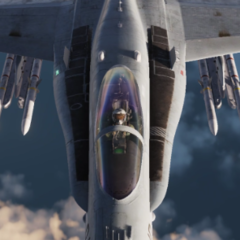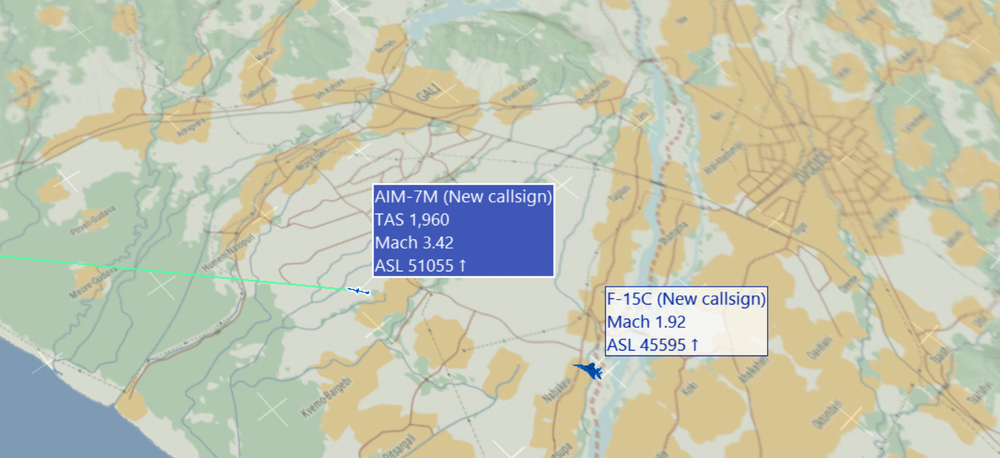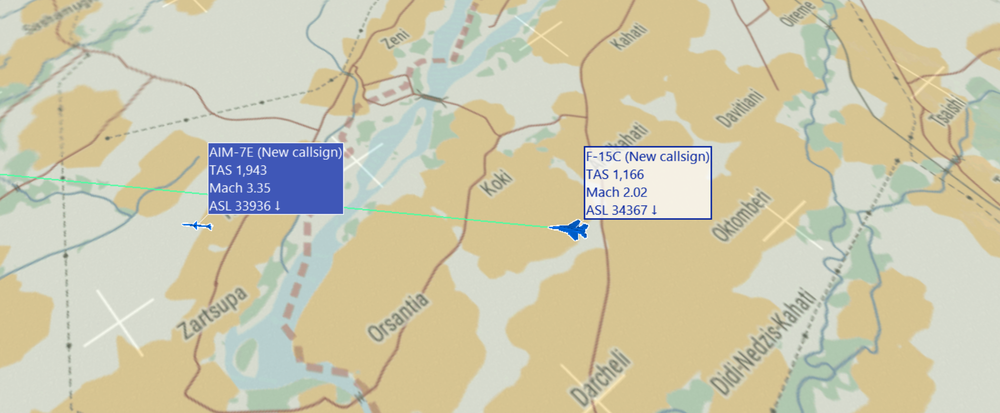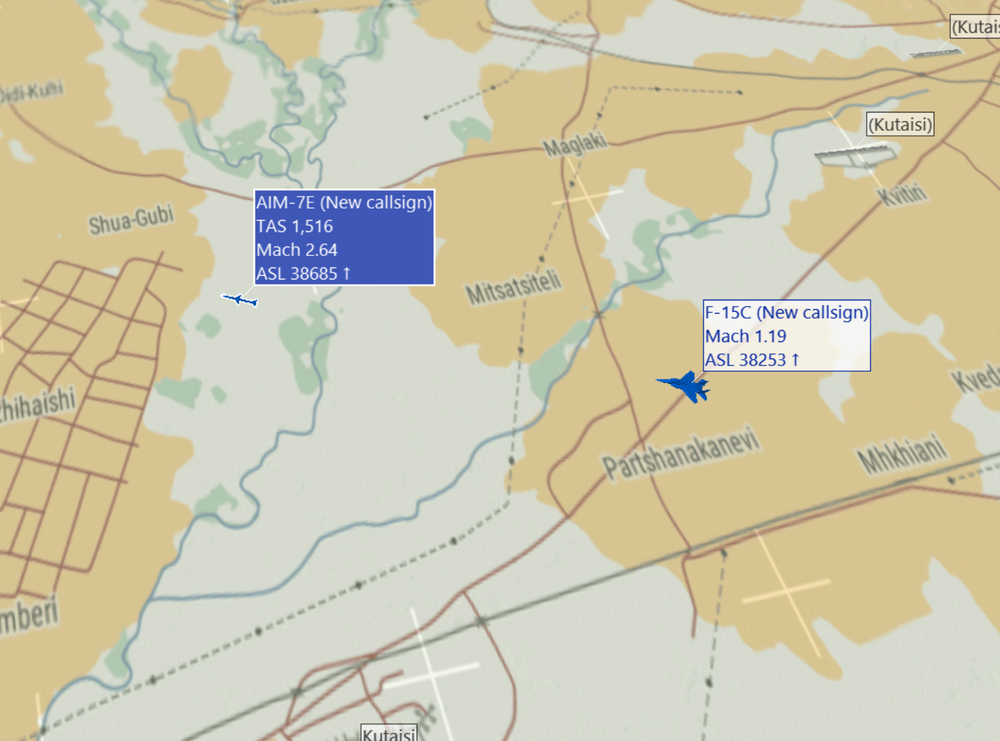-
Posts
249 -
Joined
-
Last visited
Content Type
Profiles
Forums
Events
Posts posted by DCS FIGHTER PILOT
-
-
I could very well be wrong (seeing as how the two missiles and their methods of guidance are different), but given that an Aim-7 can guide back onto a target after losing lock (at least in game as of now), is it incorrect to assume that a more advanced AMRAAM could perform similar feats?
-
On 12/17/2022 at 7:18 PM, Aquorys said:
Track history and coast is a couple seconds, but it's not anywhere close to 32
So is there any way to recover an AMRAAM that is already launched on a target that is no longer being tracked or is it done?
I would think that all you would need to do is to find and track the target again but apparently this is incorrect.
-
After launching an AMRAAM on a target, there are many reason why you might have to break away and lose radar contact with it for a brief time. In the Viper, after radar contact is lost, the FCR only stores the tracks last known state for a few seconds regardless of what value target history is set to on the FCR control page. Once it is gone, your only hope of hitting the target is if the ARMAAM finds it itself (which lately, seems very unlikely). The Hornet on the other hand, can store the track in its memory for up to 32 seconds which gives it the ability to re-acquire it even after radar contact is lost. In this case, an AMRAAM launched after radar contact loss will still successfully guide on the target.
Is the Viper's short target history a bug or is this truly how its radar works? Regardless, because of this, I have wasted many AMRAAMs that would have otherwise intercepted their targets.
-
It is my understanding that if a track file is lost/dropped while an AMRAAM, SD-10, R-77, or Aim-54 is in flight, the missile will guide to the last known estimated location of the target at the time of pitbull. In game as of now, this is also true even if the track is reacquired. I suppose the older radars and missiles that are modeled in DCS currently do not have the ability to reengage lost contacts. Fine, I guess. The problem is, if a track is lost while a fox 3 is in flight, even if the target makes a very slight deviation from its original course, the missile will fail to track.
In the track below, I fire on a target with both an Aim-120B and Aim-120C-5, the track is lost due to the excessively harsh lookdown penalty (another issue all together) and the missiles fail to track the target even though it made a slight deviation.
-
 2
2
-
-
Very cool stuff, I have been waiting on this for a very long time. In regards to the F-14’s ECM jammer, would it really act as a noise jammer (as it does now in game) or more like the Hornets jammer (it only turns on when a radar is locking it)? Also, like most other planes in DCS, would using the jammer bleed off radar performance?
-
In every picture I have seen of the F-15E, the targeting pod seems to always be there which makes me wonder, is it actually part of the jet (like the TCS on the F-14) or can it be removed (to increase performance)?
-
 1
1
-
-
44 minutes ago, coolneko said:
Before the latest patch I was able to launch a cheapshot 120 and it would hit almost every time with the AIs limited maneuvering after launch.
Heck I was able to do this most of the time against real players. Now if you drop the track for just a second (at any point in the missiles flight), you run a very high risk of the missile missing.
-
13 hours ago, Маэстро said:
Missile always go active at certain range to INS cue, this cue also defines targeting data for seeker - assumed target range, closing velocity, LOS angular rate etc. When you lose lock you drop datalink. Because target does maneuver in tracks(yes it does - it accelerates) seeker does not lock target.
Should the missile seeker still see the target (as it does not deviate much) and still go after it? Before this update that is what was happening.
-
I just ran a couple of tests. It seems to be if the radar track is lost, even for a moment, the missile fails to go active on the target and as it passes it, it goes nuts (i.e. the 40g turn and wobbling). Interestingly enough though, the Hornet still seems to be able to make the missile go active even if the track is lost briefly. In the Viper and Eagle though, as I mentioned, if the track is lost for just a second, it does not go active even though it appears to be homing in on the target (See the tracks).
AMRAAM No Pitbull.trk AMRAAM No Pitbull2.trk AMRAAM No Pitbull3.trk
-
I know someone who is a former Tomcat pilot who also test fired the Phoenix on at least one occasion. Would this individual be revealing classified military secrets if he simply confirmed or denied that the phoenix was Mach 5 capable? I mean, the last thing I would want to do is to get this person in trouble.
-
Hey guys. Forgive me for not wanting to scroll through all 300 replies on this topic but what are your thoughts on the new top speed of the missile?
To me it seems very slow now. The other day I launched a Mk47 and Mk60 at 50,000 ft and Mach 1.8 and the missile only got up to Mach 4.2.
I did not do the math on the rocket motor and Nobel geometry so I have no right to claim this is wrong but it does seem as if it’s slower than what it should be.
-
I have noticed how easy it is to shoot down enemy AI planes (even at the ace level) and I think its because of fact that they get too darn slow when defending against missiles. As you can see in the AI tracks, instead of going into full afterburner to get away from the incoming missile as fast as possible, they throttle down which makes them sitting ducks. In the second track, it almost appears as if the AI wanted the missile to smack into it. I get that the AI is a very complex topic and that there is no single or easy solution to this problem. Perhaps in the meantime the team might consider just having the defending AI plane burn away as fast as possible like in the track where I go on the defense in the Mig-29.
Better_AMRAAM_Defence.trk AI_AMRAAM_Defence.trk AI_AMRAAM_Defence2.trk
-
Similar to,
the radar look down penalty for the Viper seems too severe in some cases and appears to take on a static value, (if you will) past a certain differential altitude. As one can see in the tracks, given look up, co-alt, or very mild look down conditions , a Viper can detect and track another Viper at around 40nm. From here, if the differential altitude between the two planes is increased very slightly from the very mild look down condition, detection and tracking range plummet from around 40nm to 27nm. This number more or less holds as the differential altitude continues to increase. I'm not 100% sure how look down penalty is modeled in DCS, but I would imagine the real world mathematical relationship between detection range and differential altitude (and likely closer speed) is transcendental in nature (i.e. no sharp drop off's/discontinuities). In game right now, it appears as if (whether it is intended or not), there is a simple "step function" like relationship between all the parameters. If this is the most complex thing the team can model now I understand but if it is not, it would be nice to have this addressed in the near future as it very much impacts gameplay. Thanks.
Co-Alt.trk Look_Up.trk Mild_Look_Down1.trk Mild_Look_Down2.trk Mild_Look_Down3.trk Extreme_Look_Down.trk
-
 3
3
-
-
I know its been awhile now since it came out but thanks for adding the KS-19 and Fire can radar to the air defense arsenal guys. I put this request in the wish list awhile back and it seems as if it was received by the team! This will certainly make attacking ground assets defended by these things much more interesting now.
-
 3
3
-
-
4 Tracks From The Most Recent Open Beta Update
1st Track: Co-Altitude with Viper head on, 35,000ft Mach 1: Detection Range~45nm, Tracking Range~41nm
2nd Track: Look Up With Viper head on, Viper Altitude and Speed 35,000ft and Mach 1, Hornet Altitude and speed 20,000ft and Mach 1: Detection Range~40nm, Tracking Range~37nm.
3rd Track: Mild Look Down With Viper, Both Planes ~ Mach 1, Viper altitude 25,000ft, Hornet Altitude 35,000ft: Detection Range~30nm, Tracking Range~27nm.
4th Track: Extreme Look Down With Viper, Both Planes ~Mach 1, Viper Altitude 2500 AGL, Hornet Altitude 35,000ft: Detection Range~30nm, Tracking Range~27nm.
As one can see, there exists a striking similarity in terms of detection and tracking ranges between tracks 3 and 4 even though the differential altitude between the two aircraft is far more extreme in the later. It seems as if the radar look down penalty is simply modeled here and reverts to prescribed values regardless of altitude difference past a certain differential altitude.
Additionally, though I have not tested it thoroughly yet I believe this issue still affects the Viper.
Co-Alt.trk Look_Up.trk Mild_Look_Down.trk Mild_Look_Down.trk Extreme_Look_Down.trk
-
 2
2
-
-
Anyone willing to share a good tactic they have come up with to splash notchers flying solo? I would imagine the solution for this flying in a group would be somewhat trivial as all you would have to do is flank the target (it’s difficult to notch two or more radars at once right?)
-
Honestly I don't find the Jf-17 to be all that challenging anymore in any of the full fidelity US aircraft right now since the Jeff's radar and SD-10's were appropriately nerfed. The Viper, even though it has a weaker radar, has far better acceleration and top speed than the Jeff allowing it to more or less control the fight (i.e. it can engage and disengage as it pleases for the most part). When it comes to the Hornet its a similar story. Even though its slower than the Viper by quite a bit, its still quite a bit faster than the Thunder. In addition to this, the F-18 does appear to have a radar nearly equal in strength to the Jf-17's currently, (though the Jf-17 will detect the hornet first since its bigger but only by a few miles).
I will mention however that the Jeff does currently hold one unfair (and likely unrealistic) advantage. It is able to operate its SPJ and radar simultaneously without either one affecting the other. As we have seen in the Hornet, Viper. and recently the Mirage, activating an onboard jammer will at best weaken the strength of the radar if not shut it off completely due to the power its drawing. FC3 aircraft and the Tomcat can also currently use their jammers and radars simultaneously but I would imagine that has to due with the simplistic modeling of them.
I once tried bringing this issue up in the designated Jf-17 section of the forums but the fanboy's went somewhat ballistic.
-
20 hours ago, Dragon1-1 said:
At 40kft the air is so thin it doesn't gain much. The nozzle isn't vacuum-optimized, and the drag is already low. It'll still gain range from lofting, but max speed will be lower than if it didn't convert most of its kinetic energy into altitude. Mach 4 claims are probably something like "launched from a Tomcat at Mach 2 and 50kft", since that's how marketers roll.
AIM-7 was, IRL, a crap missile, with poor kinematics and poor reliability. You could score kills with it, but it wasn't easy. Russian Fox 1s of the time were better.
I have heard somewhere on here (I will not quote anyone as it may very well be wrong), that the PL-12/SD-10 was based off of the sparrow (and likely the AMRAAM). If the Aim-7 was such a "crappy missile" why would anyone want to base their tech off of it?
-
Additionally, I would also like to add that when launching an Aim-MH and E in game at 35,000ft and Mach 2 under standard atmospheric conditions, the top speed of both missiles is only around 1950 knots TAS or Mach 3.4, still quite below the brochure number.
If I was to guess, it seems as if the initial burn of the motors in both missiles is far too short, only allowing the missile to get up to mediocre speeds before it cuts out completely (like the E), or transitions to the sustain burn (like the MH). For reference, the total burn time for the Aim-7E and initial burn for the Aim-7MH in game is currently, around 3-3.5 seconds.
-
Please see, https://www.designation-systems.net/dusrm/m-7.html
As one can see in the table towards the end of the page, according to the article, the Aim-7A and B have a maximum speed of around Mach 2.5 while the Aim-7C, E, F, and M/P have a top speed of around Mach 4. Clearly, these are just brochure figures and that the actual top speed of the missiles is most certainly lower during most (non-ideal) engagements. However, when testing the Aim-7's in DCS, one finds that their top speeds during "ideal engagements" are much lower than expected (according to the article). As one can see in the first image below, the top speed of a lofting Aim-7MH when fired at 35000ft and Mach 1.2 under standard atmospheric conditions is around 1530 knots TAS or Mach 2.67, slightly higher than the top speed of the A and B (according to the article). In the second image, under very similar launching conditions and parameters, the top speed of an Aim-7E is around 1515 knots TAS or Mach 2.64, similar to the MH. According to the article, the similarities in top speeds are to be expected however the value of them are at least a Mach number lower than one would expect.
-
In addition to RWR's being too accurate in DCS currently, I would also like to bring up the fact that when an ARH missile is notched, it vanishes from the RWR allowing the defender to know that they have successfully notched the missile. Seeing as how the missiles radar would still be on, and that the target would still very likely be within its FOV, how is this possible? Is it because the missile is no longer "hard locking" the target or is this a bug?
-
 1
1
-
-
When I used to fly Falcon BMS, I remember routinely taking AAA fire while at 30,000 ft plus. In DCS I have never experienced such a thing (at least in a modern scenario). I am no expert on this topic but I think the weapon shooting at me in BMS was Russian 100 mm anti aircraft gun aided by the SON-9 "fire can" radar, both of which are currently not in DCS to my knowledge. Are there any plans to add these in the future?
-
 1
1
-
-
2 hours ago, BIGNEWY said:
We will take a look, but as mentioned in discord it will still be possible to notch.
And we all know you like to notch and are good at it, so the title should be "AIM 120C Still easily defeatable for me"

It certainly seems like you guys had the right intentions for this patch but it appears like there may be a bug somewhere. For as of now, notching the AMRAAM has never been easier, just take a look. Though I am very glad to hear that the team thinks that even in the last patch (when it was very difficult to notch an ARH missile) notching was still too easy.
-
 1
1
-
-
Being that the Hornet is one of my favorite aircrafts in DCS, it pains me to post this but as someone who desires realism over fun, I figure it has to be done.
With that out of the way, I posted a similar topic several months ago questioning whether or not the pylon drag on the Hornet was too low. I was told by @BIGNEWY that the pylon drag was "fixed" back in August. Though it was "fixed" I am skeptical as to whether or not it is correct along with the overall drag in general.
This time around, I have attached two tracks, one where I accelerate with full afterburner for three minutes from Mach 0.8 to around Mach 1.45 at 30,000ft under standard conditions and the other where I descend down from 45000ft to 30000ft in full afterburner (this is a little move I like to use to get the Hornet up to high speeds while conserving fuel in A2A scenarios). In each case, the outer pylons were removed and I was carrying 6 AMRAAMS (2 on each inner pylon and 2 on the belly), 2 sidewinders on the wingtips, and a pylon for the center fuel tank. In each case, its surprising how fast the Hornet gets seeing as how bulky those LAU-127's with AMRAAMS seem. (Perhaps the drag on the LAU-127 is incorrect?)
Anyway, it would be nice if all of this was correct but I can't help but feel that it is a bit too optimistic.





.thumb.png.97f351cb99407a75732891db6a2b8865.png)

Aim-120 Motor Exhaust Properties
in Military and Aviation
Posted
Hello all,
Currently doing a CFD analysis for the Aim-120B and was wondering what the properties of exhaust are so that I can model that within the CFD software.
i.e. mass flow rate, exhaust pressure, flow velocity, burn time etc.